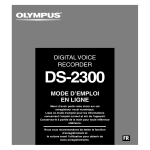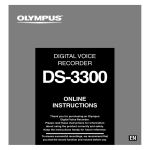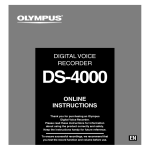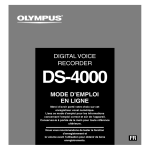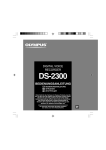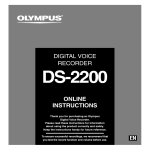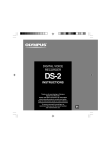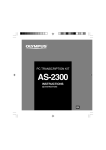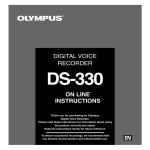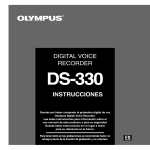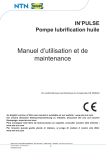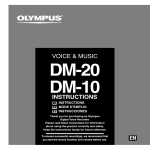Download Olympus DS-2300 User's Manual
Transcript
DIGITAL VOICE
RECORDER
DS-2300
INSTRUCTIONS
EN INSTRUCTIONS
FR MODE D’EMPLOI
ES INSTRUCCIONES
Thank you for purchasing an Olympus
Digital Voice Recorder.
Please read these instructions for information
about using the product correctly and safely.
Keep the instructions handy for future reference.
To ensure successful recordings, we
recommend that you test the record function
and volume before use.
EN
Table of Contents
Table of Contents ................................................ 2
Safe and Proper Usage ....................................... 4
General Precautions ........................................... 4
1 Getting Started
Main Features ..................................................... 6
xD-Picture Card ................................................... 8
Identification of Parts .......................................... 9
Inserting Batteries ............................................. 11
Turning ON the Recorder .................................. 12
Power Save Mode ............................................. 12
Setting Time/Date (TIME&DATE) ...................... 13
Inserting and Ejecting a Card ........................... 16
2 Basic Operations
Recording .......................................................... 18
Playing ............................................................... 22
Erasing ............................................................... 24
3 Other Functions
Index Marks ....................................................... 26
Formatting the Card (FORMAT) ....................... 27
Hold ................................................................... 29
Menu Setting Method ........................................ 30
2
4 Preparation Before Using
DSS Player
Using DSS Player Software .............................. 31
Operating Environment ..................................... 32
Installing Software ............................................. 33
Uninstalling Software ........................................ 36
Using Online Help ............................................. 38
Connection to Your PC ...................................... 39
Running DSS Player ......................................... 41
Window Names ................................................. 43
5 Managing Files on Your PC
Download Voice Files from the Recorder ......... 44
Play a Voice File ................................................ 46
Changing User ID .............................................. 47
Upgrade Function .............................................. 48
6 Other Information
Alarm Message List ........................................... 50
Troubleshooting ................................................. 51
Accessories (optional) ....................................... 52
Specifications .................................................... 53
Technical Assistance and Support .................... 54
Using the Online
Manual
When you install the DSS Player on your PC
from the CD-ROM, you can use an online
expanded version of this instruction manual,
allowing you to learn more about the digital
voice recorder.
If the DSS Player is installed, click on the [Start]
button, select [All Programs], then [ OLYMPUS
DSS Player], then click on [DS-2300 ONLINE
INSTRUCTIONS]. You can read more about the
items listed below.
Microphone Sensitivity (MIC SENSE) .........
Recording Modes (REC MODE) .................
Using the Variable Control Voice Actuator
(VCVA) ..................................................
Recording Monitor .......................................
Locking Files (LOCK) ..................................
LCD Display Information .............................
LCD Contrast Adjustment (CONTRAST) ....
Backlight (BACKLIGHT) ..............................
System Sounds (BEEP) ..............................
Upload Voice Files to the Recorder ............
Direct Recording/Editing on PC ..................
Send Voice Files with E-mail .......................
Changing a Folder Name ............................
Editing File Comments ................................
USB Microphone/USB Speaker ..................
Using Voice Recognition Software ..............
Joining Files .................................................
Splitting Files ...............................................
Menu Setting of this Recorder ....................
Using the Recorder as a Reader/Writer .....
61
62
62
63
67
75
77
79
80
1
2
3
4
5
22
23
6
24
26
31
33
38
39
40
58
60
3
Safe and Proper
Usage
Before using your new recorder, read this
manual carefully to ensure that you know
how to operate it safely and correctly.
Keep this manual in an easily accessible
location for future reference.
• The warning symbols indicate important safety
related information. To protect yourself and others
from personal injury or damage to property, it is
essential that you always read the warnings and
information provided.
Convention Used In this Manual
• The word “card” is used to refer to the xDPicture Card.
• The word “DSS Player” is used to refer to
the DSS Player version 6 in Windows and
Apple Macintosh environment.
• The Notes at the bottom of a page are used
for additional information, exceptions, or
related events.
• Words in uppercase form such as PLAY or
REC are used to describe a function or
button on the recorder.
4
General Precautions
● Do not leave the recorder in hot,
humid locations such as inside a
closed automobile under direct
sunlight or on the beach in the
summer.
● Do not store the recorder in places
exposed to excessive moisture or
dust.
● Do not use organic solvents such as
alcohol and lacquer thinner to clean
the unit.
● Do not place the recorder on top of
or near electric appliances such as
TVs or refrigerators.
● Avoid recording or playing back near
cellular phones or other wireless
equipment, as they may cause
interference and noise. If you
experience noise, move to another
place, or move the recorder further
away from such equipment.
● Avoid sand or dirt. These can cause
irreparable damage.
● Avoid strong vibrations or shocks.
● Do not disassemble, repair or modify
the unit yourself.
ecautions
● Do not operate the unit while
operating a vehicle (such as a
bicycle, motorcycle, or go-cart).
● Keep the unit out of the reach of
children.
<Warning regarding data loss>
Recorded content in memory may be
destroyed or erased by operating
mistakes, unit malfunction, or during
repair work.
It is recommended to back up and save
important content to other media such as
a computer hard disk.
Batteries
Warning
• Batteries should never be exposed to
flame, heated, short-circuited or
disassembled.
• Do not attempt to recharge alkaline,
lithium or any other non-rechargeable
batteries.
• Never use any battery with a torn or
cracked outer cover.
• Keep batteries out of the reach of
children.
• If you notice anything unusual when
using this product such as abnormal
noise, heat, smoke, or a burning odor:
1 remove the batteries immediately
while being careful not to burn
yourself, and;
2 call your dealer or local Olympus
representative for service.
5
1
Getting Started
1 Main Features
Main Features
This product is equipped with the following
features.
● Connect the USB connection cable to
enable high speed data transfer to a
computer. (☞ P.39)
● Recording and storing voice in DSS
format.
● Two recording modes, SP (Standard
Playback) mode or LP (Long Playback)
mode.
● It has a large backlight full-dot display
(LCD display screen).
• The screen displays information about
recorded voice files and easily understood
operational messages.
● The five folders can hold 199 files each,
for the maximum of 995 recordings.
(☞ P.18)
● It has a built-in Variable Control Voice
Actuator (VCVA) function.
● You can insert or delete index marks.
(☞ P.26)
• If you insert index marks during recording or
playback, you will later be able to quickly find
the recording you want to hear.
● Comes with DSS Player software. (☞ P.31)
• If you transfer voice files recorded with the
recorder to a PC, you can easily play back,
organize, and edit the files. (☞ P.44)
• If you connect the recorder to a computer, you
can use it as a USB microphone or USB
speaker.
6
● The “DSS Player” can be upgraded to a
“DSS Player Plus”, which is equipped with
a enhanced functionality (Option). (☞ P.48)
• If a commercial voice recognition software is
utilized, the recorded voice file can be
converted to characters automatically.*
• In addition to the “DSS Player” functions,
joining and splitting of the files and configuring
the menu settings of this recorder, etc. can be
performed.
Plus
The “DSS Player” can be
upgraded to “DSS Player Plus”,
which is equipped with enhanced
functionality (paid option). (☞P.48)
*: In a quiet environment, it is necessary to set
this recorder to SP mode, and that the person
whose voice is registered in the speech
recognition software speak with the constant
tone of voice when recording.
The voice file recorded under the following
conditions is not suitable for character
conversion, since the software may have
difficulty in recognizing the voice.
— Meetings, discussions where voices of more
than one person can be recorded
— Conferences, lectures where the surrounding
noise can be recorded
1
Main Features
IBM, PC/AT, and ViaVoice are the trademarks or
registered trademarks of International Business
Machines Corporation.
Microsoft, Windows and Windows Media are
registered trademarks of Microsoft Corporation.
Apple, Macintosh, iMac, Mac, and PowerMac are
trademarks or registered trademarks of Apple
Computer, Inc.
Intel and Pentium are registered trademarks of Intel
Corporation.
CORTOLOGIC is a registered trademark of
Ruwisch & Kollegen GmbH.
Other product and brand names mentioned herein
may be the trademarks or registered trademarks
of their respective owners.
ScanSoft and Dragon NaturallySpeaking are the
trademarks or registered trademarks of ScanSoft, Inc.
7
xD-Picture Card
The xD-Picture Card is a removable recording media.
1
xD-Picture Card
Compatible Cards
The removable card can be used to store different
kind of data. Since the card has larger memory
capacity than a diskette, it can be used to transfer
data between different PCs. The recorder supports
cards with memory capacity between 16 to 512 MB. 1 Index area
You can write
down the card’s
contents.
2 Contact area
Comes into contact
with the recorder’s
signal read
contacts.
Memory Sizes of Cards and Approximate Recording Times*1
Memory Size
16MB
SP Mode
LP Mode
2 hr. 30 min.
5 hr. 30 min.
32MB
5 hr. 10 min.
11 hr. 05 min.
64MB
10 hr. 25 min.
22 hr. 20 min.
128MB
20 hr. 55 min.
44 hr. 45 min.
256MB
42 hr. 00 min.
89 hr. 40 min.
512MB
84 hr. 05 min.
179 hr. 30 min.*2
*1: Available recording time for one continuous file.
Available recording time may be shorter if many
short recordings are made.
*2: Total recording time of two files. The maximum
recording time per file is 99 hours.
..............................................................................................................................................................
Notes
• When initializing (formatting) a card, confirm that no necessary data is stored on the card
beforehand. Initialization completely erases the existing data on the card.
• Cards used in a recorder must be formatted in the same recorder first unless formatted with a
CAMEDIA series Olympus digital camera. Card may not perform as expected when formatted by a
different device.
• The card has a service life. When reaching the end of its life, writing or erasing data on the card will be
disabled. In this case, replace the card.
• If you use a PC card adapter compatible with the card to save or delete some data on the card, the
maximum recording time on the card may be decreased. To recover the original recording time, initialize/
format the card in the recorder.
• Olympus will not be held liable for any data corruption or loss due to misuse of the media card.
8
Identification of Parts
1
2
3
^
4
Identification of Parts
&
1
*
5
6
(
%
$
7
)
#
8
-
@
=
9
!
q
0
w
1 EAR (Earphone) jack
# PLAY button
2 MIC (Microphone) jack
3 Built-in microphone
$ ERASE button
% DISPLAY button
4 NEW button
5 HOLD switch
^ Display (LCD panel)
& Record/Play indicator lamp
6 REC (Record) button
7 REW (Rewind) button
* POWER (ON/OFF) switch
( VOLUME (+) button
8 FF (Fast Forward) button
9 INDEX button
) VOLUME (–) button
- Card cover
0 FOLDER/MENU button
! Built-in speaker
= Card cover lock
q Battery cover
@ STOP button
w PC (USB) terminal
9
Identification of Parts
Display (LCD Panel)
1
Identification of Parts
1
2
9
8
7
3
4
6
5
1 Battery indicator
2 Folder
3 Current file number
4 Total number of recorded files in the folder
5 Character Information display
6 Erase lock indicator
7 Microphone sensitivity display
8 VCVA (Variable Control Voice Actuator)
indicator
9 Record mode indicator
10
Inserting Batteries
1
Lightly press down on the arrow and slide the
battery cover open.
Insert two AAA alkaline batteries, observing the
correct polarity.
Close the battery cover completely.
1
Inserting Batteries
2
1
2
3
Replacing batteries
The battery indicator on the display changes as the batteries
lose power.
➜
3
➜
➜
When
appears on the display, replace the batteries as
soon as possible.
When the batteries are too weak, the recorder shuts down
and “BATTERY LOW” appears on the display.
An optional Ni-MH Rechargeable Battery from Olympus
can be used for the recorder (☞ P.52).
....................................................................................................................................................
Notes
• Be sure to turn OFF the recorder before replacing the batteries. Removing the batteries while the recorder
is in use may corrupt the card. If you are recording into a file and the batteries run out, you will lose your
currently recorded file since the file header will not be written. It is crucial to replace the batteries when
one hash mark in shown in the battery icon.
• Be sure to replace both batteries at the same time.
• Never mix old and new batteries, or batteries of different types and/or brands.
• If it takes longer than 1 minute to replace dead batteries, you may have to reset the time when you load
fresh batteries (☞ P.13).
• Remove the batteries if you are not going to use the recorder for an extended period of time.
11
Turning ON the Recorder
1
Turning ON the Recorder/ Power Save Mode
With the battery in the recorder and the card inserted properly,
the recorder is ready to work.
While the power switch on the back of the recorder is in the
OFF position, none of the buttons or switch on the recorder
will be active. Slide the power switch to the ON position to
activate the recorder.
Power Save Mode
When the recorder is ON but not in use for 10 minutes, it will switch to power save mode
automatically. To reactivate the recorder again, press any of the buttons on the recorder.
12
Setting Time/Date (TIME&DATE)
Setting the correct time and date on the recorder is very important since every file recorded on
the recorder will have the date and time information as part of the file header. This will simplify
the file management aspects later on.
REC button
(Accepts a choice and moves
on to the next item)
DISPLAY
button
(Switching the
data displayed.)
FF/REW
button
(Alters a choice)
1
Set the hour.
1 Press the FF button or REW button to set
the hour.
2 Press the REC button to accept the hour.
• You can choose between 12 and 24 hour
display by pressing the DISPLAY button
while setting the hour and minute.
Example: 5:45 P.M.
5:45 PM ←→ 17:45
(Initial setting)
2
Set the minute.
3
Set the year.
Setting Time/Date (TIME&DATE)
The hour indicator will flash automatically when you load batteries before using the
recorder for the first time, or after the recorder hasn’t been used for a long time.
Proceed from step 1.
1
1 Press the FF button or REW button to set
the minute.
2 Press the REC button to accept the minute.
1 Press the FF button or REW button to set
the year.
2 Press the REC button to accept the year.
13
Setting Time/Date (TIME&DATE)
REC button
1
• You can choose the order of the year, month,
day by pressing the DISPLAY button while
setting them.
Example: March 14, 2005
3M 14D 2005Y
(Initial setting)
↓
14D 3M 2005Y
↓
2005Y 3M 14D
(Accepts a choice and moves
on to the next item)
Setting Time/Date (TIME&DATE)
DISPLAY
button
(Switching the
data displayed.)
FF/REW
button
(Alters a choice)
4
Set the month.
5
Set the date.
1 Press the FF button or REW button to set
the month.
2 Press the REC button to accept the month.
1 Press the FF button or REW button to set
the date.
2 Press the REC button to accept the date.
.............................................................................................................................................................
Notes
• If you press the STOP button during the setup operation, the recorder will save the items that were set to
that point.
• You can set the time and date from your PC using DSS Player software (☞ P.31).
14
Changing the Time/Date
The menu appears (☞ P.30).
2,4
3
1,5
2
Press the FF or REW button to
choose “SUB MENU”, and press
the REC button.
The sub menu appears (☞ P.30).
3
4
Press the FF or REW button until
“TIME&DATE” flashes on the
display.
5
Press the FOLDER/MENU button
to close the menu.
1
VCVA
REC MODE
MIC SENSE
SUB MENU
EXIT
SUB MENU
VCVA
REC MODE
Setting Time/Date (TIME&DATE)
1
Press and hold the FOLDER/
MENU button for 1 second or
longer.
Press the REC button.
Time/Date screen appears. The hour
indicator flashes, indicating the start of
the Time/Date setup process.
Follow the same steps starting at step 1
in “Setting Time/Date” (☞ P.13).
15
Inserting and Ejecting a Card
Inserting a Card
1
Inserting and Ejecting a Card
1
1
Slide the card cover lock in the direction indicated
by the arrow.
2
Face the card the correct way and insert it into
the card slot as shown in the diagram.
3
Close the card cover securely.
2
3
The card cover is unlocked and the message “CARD COVER IS
OPEN” appears on the display. When this message appears, the
power is switched off automatically.
• Insert the card keeping it straight.
• The card stops with a click when it is inserted all the way.
• Inserting the card the wrong way or at an angle could
damage the contact area or cause the card to jam.
• If the card is not inserted all the way, data may not be
written to the card.
Card inserted fully into the slot
The message “PLEASE WAIT” on the display flashes for
seconds.
Card not inserted fully into the slot
When the card cover is closed, the message “INSERT CARD”
on the display flashes for a few seconds. Pressing any button
will sound beeps* and flash the message “INSERT CARD”
again.
* When the system sounds are enabled.
..............................................................................................................................................................
Notes
16
• If an unformatted card is inserted, the recorder automatically displays the menu to menu format option
(☞ P.27).
• Never use any card in the recorder unless it has been formatted on this unit or on a CAMEDIA series Olympus
digital camera (☞ P.27).
Ejecting a Card
3
4
1
2
Make sure the recorder is STOP mode.
3
Push the card inward to unlock it, and let it eject
partially.
4
Hold the card straight and pull it out.
Slide the card cover lock in the direction
indicated by the arrow.
The card cover is unlocked and the message “CARD
COVER IS OPEN” appears on the display. When this
message appears, the power is switched off automatically.
Inserting and Ejecting a Card
2
1
The card is visibly out of the slot and can be removed safely.
..............................................................................................................................................................
Note
Releasing your finger quickly after pushing the card inward may cause it to eject forcefully out of the slot.
17
2
Basic Operations
Recording
2
Recording
The recorder has five folders, A, B, C, D, E and you can select folder by pressing the
FOLDER/MENU button. These five folders can be selectively used to distinguish the kind of
recording; for example, Folder A might be used to store private information, while Folder B
might be dedicated to holding business information. You can use your DSS player to change a
folder name. Up to 199 messages can be recorded per folder.
All recordings made in any of the folders will be in Digital Speech Standard (DSS) format. By
default, the RECORD function is configured to record at the current position (overwrite). However,
that can be changed to any of the following settings:
• Append: Appends the recording to the end of the current file.
• Insert: Inserts the recording at the current position in the file.
• Overwrite: Overwrites the recording starting at the current position in the file.
New Recording
Create a new file to record in.
Built-in
microphone
3
2
1
1
Press the FOLDER/MENU button
to choose a folder.
2
Press the NEW button to create
a new file.
3
The folder name is displayed for 2
seconds.
a Current recording mode
b New file number
c Selected Author ID
c AUTHOR A
NEW F I LE
REMA I N :
4H33M12S
Press the REC button to start
recording.
The record/play indicator lamp glows red.
Aim the microphone at the sound source.
d Current recording time
e Remaining recording time
18
a
b
d
e
AUTHOR A
00M05S
4H33M07S
Press the STOP button to stop
recording.
If you want to append additional recordings
to the same file, press the REC button
again.
Pause
4
2
Recording
4
Press the REC button while recording.
➥ “REC PAUSE” will flash on the display.
• The recorder stops when it has been left paused for 10 minutes or
longer.
Resume Recording
Press the REC button again.
➥ Recording will resume at the point of interruption.
Review Recording
Press the REW button when recording, and release it when you want to start playback.
The recorder plays up to the end of file, then stops.
You can overwrite or append additional recordings in the same file from that point.
.............................................................................................................................................................
Notes
• A beep will sound when remaining recording time reaches 60 seconds, 30 seconds, and 10 seconds while
recording.
• “MEMORY FULL” or “FOLDER FULL” will be displayed when the memory or folder capacity is full. Delete
any unnecessary files before recording any further (☞ P.24) or transfer voice files to your computer using
DSS Player Software (☞ P.31).
• You cannot select a different recording mode (SP or LP) than that of the original file when appending
recording.
• While recording, pressing the PLAY button stops recording and plays back the current file.
19
Recording
Overwrite Recording
You can overwrite a previously recorded file from any point within the file.
Note that the overwritten recordings will be erased.
2
Recording
3
4,6
1
Press the FOLDER/MENU button
to choose a folder.
5
2
2
Press the FF or REW button to
choose the file into which you want
to overwrite.
1
3
Press the PLAY button to play the
file.
4
5
6
The folder name is displayed for 2
seconds.
a Current playback time
b Total recording time of the file being
played
AUTHOR A
00M00S
LENGTH :
27M58S
a
b
AUTHOR A
00M05S
LENGTH :
27M58S
Press the STOP button where you
want to start overwriting.
Press the REC button to start
overwriting.
The record/play indicator lamp glows red.
Press the STOP button to stop
overwriting.
AUTHOR A
10M25S
14M00S
.............................................................................................................................................................
Note
You cannot select a different recording mode (SP, LP) than that of the original file before overwrite recording.
20
Insert Recording
Additional recording can be inserted into previously recorded file.
1,4
Press the FOLDER/MENU button
to choose a folder.
2
3
4
Press the FF or REW button to
choose the file into which you want
to insert additional recordings.
2
Recording
3
6
5
2
1
The folder name is displayed for 2
seconds.
Press the PLAY button to start
playback.
While playing the file, press the
FOLDER/MENU button to insert
an additional recording.
“INSERT ?” appears on the display.
AUTHOR A
00M00S
LENGTH :
27M58S
AUTHOR A
00M10S
INSERT ?
02M25S
5
Press the REC button to start
inserting additional recording.
The record/play indicator lamp glows red.
“INSERT REC” and the remaining
recording time will alternate on the display.
AUTHOR A
00M11S
4H33M06S
6
Press the STOP button to stop
inserting additional recording.
AUTHOR A
00M12S
I NSERT REC
.............................................................................................................................................................
Notes
• The recording time and date of the file is updated to the time and date of the inserted recording.
• You cannot select a different recording mode (SP, LP) than that of the original file before inserting.
21
Playing
2
Playing
3
5
2
1
1
2
Press the FOLDER/MENU button
to choose folder.
3
Press the PLAY button to start
playback.
Press the FF or REW button to
choose the file that you want to
play.
The record/play indicator lamp glows
green.
a Current playback time
b Total recording time of the file being
played
4
4
Press the VOLUME (+ ) or
VOLUME (–) button to select the
proper sound volume.
The display shows the volume level. You
can choose between 0 to 30.
5
Press the STOP button at any
point you want to stop the
playback.
Resume playback by pressing PLAY
button again.
22
AUTHOR A
00M00S
LENGTH :
27M58S
a
b
AUTHOR A
00M05S
LENGTH :
27M58S
Playback functions
Playback
functions
Operation
How to Cancel
Press the FF button once while stopped.
Cue
(CUE)
Review
(REV)
Hold the FF button while stopped or playing a file.
Release the FF button.
Hold the REW button while stopped or playing a file.
Release the REW button.
Press the PLAY button.
➥ The recorder starts the operation of
the set position.
Press the REW button once while stopped.
2
Playing
Fast
Forward
(FF)
Rewind
(REW)
• If you press the FF button once while fast-forwarding or twice while stopped, the recorder will stop at the
end of the file (F.SKIP).
• If you press the REW button once while rewinding or twice while stopped, the recorder will stop at the
beginning of the file (B.SKIP). If the REW button is pressed within 2 seconds, the recorder skips to the
beginning of the previous file.
23
Erasing
Erasing One File
A selected file can be erased from a folder.
2
Erasing
3,4
2
1
2
3
Press the FOLDER/MENU button
to choose a folder.
Press the FF or REW button to
choose the file you want to erase.
Press the ERASE button.
“FILE ERASE ?” flashes on the display
for approximately 8 seconds.
FOLDER A
F I LE
ERASE ?
1
4
Press the ERASE button once
more while “FILE ERASE ?” is
flashing.
The display changes to “FILE ERASE!”
and erasing will start.
FOLDER A
F I LE
ERASE !
{
“ERASE DONE” is displayed when the file
is erased. File numbers will be reassigned
automatically.
FOLDER A
ERASE DONE
....................................................................................................................................................
Notes
• An erased file cannot be restored.
• The file set to erase lock will not be erased.
24
Erase All Files in a Folder
All files in a folder can be erased simultaneously, except for locked files.
1
2
Press the ERASE button for 3
seconds or longer.
3
“ALL ERASE ?” flashes on the display
for approximately 8 seconds.
Press the ERASE button once
more while “ALL ERASE ?” is
flashing.
The display changes to “ALL ERASE!”
and erasing will start.
2
Erasing
2,3
1
Press the FOLDER/MENU button
to choose the folder you want to
erase all files.
FOLDER A
ALL ERASE ?
FOLDER A
ALL ERASE !
{
“ERASE DONE” is displayed when the files
are erased. Locked files are reassigned file
numbers in ascending order.
FOLDER A
ERASE DONE
....................................................................................................................................................
Notes
• An erased file cannot be restored.
• The file set to erase lock will not be erased.
• Completion of erasing may take 10 seconds. Never do anything during this period because data may be
corrupted. Battery removal setting/removal are not permissible, whether or not the battery is set in the
recorder.
25
3
Other Functions
Index Marks
Index marks can be placed in a file during recording or playback to provide and quick and easy
way of keeping track of important sections in the file.
3
Setting an Index Mark
Index Marks
1
Press the INDEX button during
recording or playback to set an
index mark.
An index number appears on the display.
4
2
1
AUTHOR A
12M05S
I NDEX 08
SET
Locating an Index Mark
2
Hold the FF or REW button while
playing a file.
The recorder stops for 1 second when it
reaches the index mark.
Clearing an Index Mark
3
4
Locate the index mark you want
to clear.
Press the ERASE button while the
index number appears for
approximately 2 seconds on the
display.
The index mark is erased.
AUTHOR A
12M05S
I NDEX 08
CLEAR
....................................................................................................................................................
Notes
26
• Up to 16 index marks can be set in a file. Attempting to set more index marks will cause “INDEX FULL” to
appear on the display.
• Index marks cannot be set or cleared in a locked file.
Formatting the Card (FORMAT)
Cards that have been used on non-Olympus devices, or cards that are not recognized by the
recorder, must be formatted before they can be used with the recorder. The Olympus
xD-Picture Card delivered with the recorder is preformatted and ready for use.
To familiarize yourself with the formatting process, read the steps below.
1
Press and hold the FOLDER/
MENU button for 1 second or
longer.
3
2,4,6
3
5
1
2
Press the FF or REW button to
choose “SUB MENU”, and press
the REC button.
The sub menu appears (☞ P.30).
3
4
5
Press the FF or REW button to
until “FORMAT” flashes on the
display.
EXIT
SUB MENU
VCVA
REC MODE
FORMAT
EX I T
CONTRAST
Formatting the Card (FORMAT)
The menu appears (☞ P.30).
Press the REC button.
The formatting process is selected.
Press the FF button to choose
“START”.
CANCEL
START
6
Press the REC button.
“DATA WILL BE CLEARED” appears for
approximately 2 seconds.
DATA W I LL
BE CLEARED
27
Formatting the Card (FORMAT)
3
Press the FF button again to
choose “START”.
8
Press the REC button again.
SURE?
CANCEL
START
Formatting begins and an indicator
flashes on the display.
FORMAT!
{
Formatting the Card (FORMAT)
8
7
7
“FORMAT DONE” displays when formatting
ends.
FORMAT
DONE
....................................................................................................................................................
Notes
• The time required to format cards differs depending on the capacity of cards. For example, formatting may
take about 1 minute for 512 MB card. Do not interrupt the formatting process by opening the card cover or
the battery cover. Doing so will damage the data or card.
• When the card is formatted, all the stored data, including locked files, are erased.
• If an unformatted card is inserted, the recorder automatically displays the format option in the menu.
28
Hold
Setting the HOLD switch to the HOLD
position.
If you set the recorder to HOLD status by sliding
the HOLD switch in the direction of the arrow, the
current conditions will be preserved, and all buttons
and switches except the HOLD switch will be
disabled. This feature is useful when the recorder
has to be carried in a bag or pocket.
3
Hold
Remember to reset the HOLD switch when
using the recorder.
....................................................................................................................................................
Notes
• The display will flash if the switch is moved to hold in the stop status. At this time, if any button is pressed
the clock display will flash for about 2 seconds, but will not operate.
• If the switch is moved to hold during playback (or recording), the playback (recording) status will stay and
cannot be operated.
(When playback has ended and the recording has ended due the remaining memory being used up, it will
be in the stop state.)
29
Menu Setting Method
Each item of the menu list can be set by the following method.
Press and hold the FOLDER/MENU button for 1 second or longer.
MENU
3
REC MODE
Select SP or LP mode.
MIC SENSE
Microphone sensitivity setting. Select
between CONF (high-sensitivity mode) or
DICT (low-sensitivity mode).
Menu Setting Method
EXIT
SUB MENU
Exit MENU and return to STOP mode.
Switches to the SUB MENU.
VCVA
VCVA setting. Select ON (enabled) or OFF
(disabled).
LOCK
Locking files setting. Select ON (locked) or
OFF (unlocked).
BEEP
System sounds setting. Select ON (enabled)
or OFF (disabled).
SUB MENU
FORMAT
EXIT
Recorder formatting (☞ P.27).
Returns to the MENU.
CONTRAST
LCD contrast adjustment. Select the level
from 1 to 12.
BACKLIGHT
Backlight setting. Select ON (enabled) or
OFF (disabled).
TIME&DATE
Time/Date setting. Hour, minute, year, month
and day (☞ P.13).
Press the FF
button or REW
button.
Press the
REC button.
Notes
30
• If you press the STOP button or FOLDER/MENU button during a menu setup operation, the recorder will
stop and apply the items that were set to that point.
• The recorder will stop if you leave it idle for 3 minutes during a menu setup operation, when a selected item is
not applied.
• You can set the time and date on the recorder from your PC using DSS Player software (☞ P.31).
4
Preparation Before Using DSS Player
Using DSS Player Software
The DSS Player Software can be used to do the following:
• Playback voice files on your PC and on the recorder when connected via USB. Download
files from the recorder to the PC or upload files from the PC to the recorder.
• If an upgrade (Option) to DSS Player Plus is executed, various additional functions can be
utilized (☞P.48).
4
Precautions on using the recorder connected to a PC
● If folders or files stored on the recorder
are moved or renamed by using a file
management tool such as Explorer or
Finder, the order of files may be
changed or files may become
unrecognizable.
● On a PC, do not format the drive of the
recorder. Initialization is not successfully
achieved on a PC. For initialization, follow
the instructions in the menu screen of
the recorder (☞ P.30).
● As the noise may cause adverse effects
on electronic devices nearby the
recorder, unplug the earphone when
you connect the recorder to a PC.
● Data can be written or uploaded to the
recorder even though the attribute of
the recorder drive is shown as Readonly by the operating system of the PC.
Using DSS Player Software
● When you are downloading a file from
the recorder or uploading a file to the
recorder, do not remove the USB cable
even if the screen is indicating you can.
Data is still being transferred while the
record/play indicator lamp is blinking.
When removing the USB cable, be sure
to follow the description in ☞P.40. If the
USB cable is removed before the drive
is stopped, data may not be
successfully transferred.
● Folder (directory) names displayed by
file management tools such as Explorer
attached to Microsoft Windows and
Finder attached to Mac OS are different
from the folder names settable with the
recorder or DSS player.
31
Operating Environment
Basic Operating Environment of DSS Player
Macintosh
Windows
PC:
Operating
System:
CPU:
4
Operating Environment
32
RAM:
Hard drive
space:
Drive:
IBM PC/AT compatible PC
Microsoft Windows Me/ 2000
Professional/XP
Professional,Home Edition
Intel Pentium II class 333
MHz processor or more
(Processor 500 MHz or faster
is recommended)
128MB or more (256MB or
more is recommended)
50MB or more
2x or faster CD-ROM, CD-R,
CD-RW, DVD-ROM drive
Sound card: Creative Labs Sound Blaster
16 or 100% compatible
sound card
Browser:
Microsoft Internet Explorer
4.01 SP2 or later
Display:
800 x 600 pixels or more, 256
colors or more
USB port:
One free port
Audio I/O
Earphone output or speakers
terminals:
Others:
• The mouse or similar to a
pointing device.
• Environment where the
Internet can be utilized.
PC:
Operating
System:
RAM:
Hard drive
space:
Drive:
Display:
USB port:
Audio I/O
terminals:
Power Mac G3 233 MHz
class processor or faster
iMac/ iBook/ eMac/ Power
Mac/ PowerBook
(The computer must support
a standard USB port)
(Processor 500 MHz or faster
is recommended)
Mac OS 10.1/10.2/10.3
128MB or more (256MB or
more is recommended)
50 MB or more
2x or faster CD-ROM, CD-R,
CD-RW, DVD-ROM drive
800 x 600 pixels or more, 256
colors or more
One free port
Earphone output or speakers
Installing Software
Before you connect the recorder to your PC and use it, you must first install the DSS player
software from the included Software CD.
Applications included with “DSS Player”
• DSS Player: Recorded voice files can be downloaded to the PC for complete file management and playback
solution.
• Acrobat Reader is installed on your PC. It is required to view the accompanying manual in PDF format.
Be sure to confirm the following before installation:
• Exit all running applications.
• Eject the floppy disk if you are using one.
4
• If you are running Windows2000/XP or Mac OS X on the network, you need to log on as an Administrator.
1
Insert DSS Player into the CD-ROM
drive.
2
3
Click the [start] button and select
[Run].
The installation program will start
automatically. Once the program starts,
jump to step 4. If it does not, follow the
procedures in steps 2 and 3.
4
The installation Language
Selection dialog box opens.
Click the desired language to select it.
Installing Software
Windows
Enter “D:\setup.exe” in the [Open]
field and click [OK] .
This is assuming the CD-ROM drive is D.
33
Installing Software
Installing DSS Player
5
4
Installing Software
6
Register user information.
Enter your name, company name and
serial number. For the serial number,
see the label attached to the CD-ROM
package provided with DSS Player.
When entered, click [Next]. When the
confirmation dialog appears, click
[Yes].
Select where to install DSS
Player.
This lets you specify the folder in which
to install DSS Player. Click [Browse] to
find the desired installation folder. To
accept the default folder, click [Next].
Note
If the installation folder does not exist, a
confirmation dialog box opens to get your
permission to create a folder for this
purpose. Click [Yes].
8
34
Select a program menu folder.
You may change the program menu folder
to another one, such as [Start Up]. To
accept the default folder, click [Next].
Authorizing the start of file
copying.
Confirm all “Current Settings”. To accept
them, click [Next].
Note
To change the program menu folder or
installation folder, click [Back].
10
Confirm your acceptance of
the terms of the Licensing
Agreement.
You must accept the terms of the
Licensing Agreement to install DSS
Player. If you accept them, click [Yes].
7
9
Copy files.
Wait until DSS Player is installed on
your PC, then click [Finish].
The screen returns to the opening
screen automatically.
Installing the Device Driver
11
Connect the recorder to your PC,
referring to “Connection to Your
PC” (☞ P.39).
When you connect the recorder to your
PC for the first time after installing DSS
Player, the recorder’s driver will be
installed automatically. If the driver is
installed properly, DSS Player will start
automatically.
(For details about operation for DSS
Player see pages from P.41)
Macintosh
6
Select where to install DSS Player.
Double-click CD icon.
Double-click the desired language to
select it.
Double-click the following icon.
Click [Continue] when the DSS
Player opening screen appears.
Confirm your acceptance of the
terms of the Licensing Agreement.
You must accept the terms of the
Licensing Agreement to install DSS
Player. If you accept them, click [Agree].
7
8
Completing setup.
Installation has finished. Click [Quit].
Register user information.
To use the DSS Player, it is necessary to
register the user information at the time
of initial startup.
Open the [DSS Player] folder created at
installation, and the user’s registration
is
screen will be displayed, if the
double clicked. Please input your name,
company name, and serial number.
Please see the seal attached to the CDROM package included with the DSS
Player, for the serial number. After the
input has ended, click [OK] to complete
the registration.
4
Installing Software
1
2
3
4
5
Insert DSS Player into the CD-ROM
drive.
This lets you specify the folder in which
to install DSS Player. To accept the default
folder, click [Choose].
Installing DSS Player.
35
Uninstalling Software
To uninstall any of the software component of the DSS player software installed on your PC,
follow the steps below.
Windows
4
Uninstalling Software
1
2
3
4
5
6
7
Exit DSS Player.
Select [Control Panel] from [start] menu.
Click [Add/Remove programs] in the control panel window.
A list of applications that have been installed is displayed.
Select the software you would like to uninstall/remove.
Click [Change/Remove].
Confirmation of Deleting the program.
Click the [OK] button to start uninstalling.
An additional message may appear, if so, read it carefully and follow the instructions given.
When the [Maintenance Complete] screen is displayed, click [Finish] to
complete uninstalling.
....................................................................................................................................................
Note
The voice files you made are stored in the [MESSAGE] folder. If you don’t need them, delete them. You can
confirm the location of the [MESSAGE] folder by clicking [Options] in the [Tools] menu before uninstalling.
36
Macintosh
Exit DSS Player.
Delete the Preferences File.
Delete the [DSS Preference] file in the following location.
Macintosh HD : Users : Library : Preferences
Delete the Executable File.
4
Delete the [DSS Player] file in the location where you installed the file.
Delete the Help File.
Delete the [DSS Player Help] file in the following location.
System Folder : Help
....................................................................................................................................................
Note
The voice files you made are stored in the [MESSAGE] folder. If you don’t need them, delete them. You can
confirm the location of the [MESSAGE] folder by clicking on [Options] in the [Tools] menu before uninstalling.
Uninstalling Software
1
2
3
4
37
Using Online Help
For information on the DSS Player usage and features, refer to the Online Help.
To open Online Help, you have the following options.
Windows
• Click the [start] button, select [All Programs], then [Olympus DSS Player], then click [Help].
• While DSS Player is running, choose [Contents] from the [Help] menu.
• While DSS Player is running, press [F1] on the keyboard.
Macintosh
• While DSS Player is running, choose [DSS Player Help] from the [Help] menu.
Search by Contents
4
Using Online Help
1
2
3
Once the Online Help screen appears, click
the Contents tab.
Double-click the
topic heading.
icon of the desired
The title of the topic is displayed.
Double-click the
icon of the desired topic.
An explanation of the topic is displayed.
1
2
3
Search by Key word
1
2
3
Once the Online Help screen appears, click
the Index tab.
Enter text.
Matching keywords are located automatically.
Choose a topic, then click [Display].
1
2
An explanation of the topic is displayed.
3
....................................................................................................................................................
Note
38
You will be able to use Online Help after DSS Player is installed.
Connection to Your PC
Be sure to install the DSS Player software before connecting the recorder to a PC.
You can directly connect the recorder’s USB terminal to your PC.
Connecting to your PC Using the USB
Cable
Turn ON the recorder (☞ P.12).
4
Insert end A of the USB cable to
your PC’s USB port or USB hub.
Make sure the recorder has
stopped before attaching end b
of the USB cable to the terminal
port of the recorder.
REMOTE
If “REMOTE” is displayed on the
recorder, it indicates proper
connections.
Connection to Your PC
1
2
3
Once you connect the recorder to your PC, the recorder will
be powered through the USB cable. The batteries will not
be in use.
Windows
When the recorder is connected and “My Computer” is
opened, a removable disk drive is displayed. If “Add New
Hardware Wizard” appears, cancel the wizard by pressing
the [Cancel] button and then install DSS Player.
Macintosh
If the recorder is connected to Mac OS, an icon with a drive
name of “Untitled” appears.
39
Connection to Your PC
Disconnecting from Your PC
Windows
1
Click the
on the task bar
located at the lower-right corner
of the screen. Click [Safely
Remove Hardware].
It will read [Stop USB Disk-Drive] for
Windows Me. The drive letter will differ
depending on the PC being used.
4
Connection to Your PC
2
Disconnect the USB cable.
1
Macintosh
1
2
Move the icon of the recorder's drive displayed on desktop to trash box by
drag and drop.
Disconnect the USB cable.
....................................................................................................................................................
Notes
• NEVER remove the card or disconnect the USB cable while the record/play indicator lamp is flashing. If you
do, the data on the card will get destroyed.
• When the recorder is connected to a PC, the power will be supplied from the USB cable.
• Refer to the user’s manual for your PC regarding the USB port or USB hub on your PC.
• Be sure that you connect the USB cable either directly to the USB port on your PC or the self-power (AC
adapter connection) USB hub.
• Be sure to push the cable connector all the way in. Otherwise, the recorder may not operate properly.
40
Running DSS Player
Windows
By connecting the recorder to your PC, you can automatically start the application.
Disabling automatic start
1
Right click on the
of the taskbar on the
lower right of the screen, and select [Setting].
2
Click the
The application which enables setting will be displayed
by dialog.
4
The check mark on [DSS Player Version 6] disappears.
For automatic start, select and click DSS Player to
reinstate again.
2
2
3
Manual start
1
2
3
Running DSS Player
of the [DSS Player Version 6].
Start Windows.
Click the [start] button, select [All
Programs], then [Olympus DSS
Player].
Click [Olympus DSS Player].
2
..............................................................................................................................................................
Note
You cannot run more than one DSS Player program or multiple copies of the same program simultaneously.
41
Running DSS Player
Macintosh
To start, open the “DSS Player” folder created upon installation and double-click the
icon.
When it starts for the first time after installation, user information needs to be registered.
Please see ☞P.35 for details.
4
Running DSS Player
....................................................................................................................................................
Note
The Mac version DSS Player has no automatic start function.
42
Window Names
* Main screen displayed when
DSS Player is started
1
2
4
4
Window Names
3
1
Macintosh
Windows
2
4
3
1 Play Control Bar
Control buttons to play and stop voice files.
2 Dictation Folder Window
Will display the directory structure of the DSS,
WMA, WAVE (Windows only) and AIFF
(Macintosh only)-format files stored on your
PC’s hard disk.
3 Device Manager Window
Will display the directory structure of the folders
in the recorder.
4 Voice File List Box
Will display the voice files in the folder selected
in 2 and 3.
43
5
Managing Files on Your PC
Download Voice Files from the Recorder
There are 3 download options to transfer voice files from the recorder to the PC:
• Download Selected Files
Download one or several voice files to your PC.
• Download Folders
Download all the voice files in one folder.
• Download All
Click the
icon and download all the voice files stored in the recorder to your PC.
The following is an explanation of “Download Selected Files”. For explanations of “Download
Folders” and “Download All”, refer to Online Help.
5
Download Voice Files from the Recorder
1
Select the folder.
2
Select the voice file.
From the Device Manager window, select the folder
that contains the voice file you would like to download.
The illustration shows that Folder A has been
selected.
1
Select the voice file you would like to download from
the Voice File List Box. To select more than one file,
hold either the [Ctrl] or [Shift] key and select files.
The illustration shows that one voice file is selected.
2
44
order
3
Download the voice file.
Windows
From the [Download] menu, click
[Download Selected Files].
Macintosh
From the [Tools] menu, click
[Download Selected Files].
5
4
Do not disconnect the USB cable while
the record/play indicator lamp on the
recorder is flashing. Disconnecting the
USB cable when the recorder lamp is
flashing will result in data loss or
corruption.
..............................................................................................................................................................
Notes
• NEVER remove the card or disconnect the USB cable while the record/play indicator lamp is flashing. If
you do, the data on the card will get destroyed.
• Depending on the size of the voice file and your PC, it may take some time to download the files.
• The downloaded files will be stored in the download tray folder that corresponds to the folder in the
recorder.
(Example: A voice file downloaded from Folder A will be stored in download tray A on your PC.)
• If a voice file already exists on your PC with the same name, date and time recorded, the new file will not
be downloaded.
Download Voice Files from the Recorder
3
Download complete.
45
Play a Voice File
1
2
3
5
Select the folder.
Select the folder that contains the voice
file you would like to play.
1
2
Select the voice file.
Select the voice file to play from the Voice
File List Box.
Play the voice file.
Click the
Control Bar.
(play) button of the Play
Play a Voice File
Other playback control such as Rewind, Fast
Forward, Stop, Speed Control, Volume
Control, Time Axis and Index Skip are
available from the Play Control Bar.
3
File Name Format
File names are assigned in the following manner:
DS23 0001.DSS
Extension
File number ....... A serial number automatically assigned by a Digital Voice Recorder.
User ID ....... The name that has been set on the Digital Voice Recorder. The default name on the
Digital Voice Recorder is “DS23”. The user ID can be modified with DSS Player (☞ P.47).
46
Changing User ID
The user ID is used in file names that are recorded on a Digital Voice Recorder.
1
Enter the user ID in the [Transfer User ID]
window.
Windows From the [Download] menu.
Macintosh From the [Tools] menu.
2
Click [Transfer].
The new user ID will be transferred to the Digital Voice
Recorder.
1
2
....................................................................................................................................................
Note
5
Changing User ID
NEVER remove the card or disconnect the USB cable while the record/play indicator lamp is flashing. If you
do, the data on the card will get destroyed.
47
Plus
Upgrade Function
The “DSS Player” enables upgrades (Options) to the “DSS Player Plus” which is equipped with
more functions. In addition to the DSS Player functions, voice recognition using voice recognition
software, joining of files, sharing of files and the menu setting of this recorder can be utilized.
Purchase and Upgrade
To purchase “DSS Player Plus” and upgrading from “DSS Player” is operated in the following
procedures.
Windows
5
Upgrade Function
1
2
Macintosh
Start the DSS Player.
Please see ☞ P.41 for the starting method.
Click the
button or select [Purchase
a new license for DSS Player Plus] in
the [Help] menu.
The web browser will start and the purchase
site of the DSS Player Plus will be displayed.
Please operate according to guidance on the
screen.
When the purchase procedure is completed, the
license number will be issued by mail.
2
48
3
Select [Upgrade to DSS Player Plus]
from the [Help] menu.
The “Upgrade to DSS Player Plus” dialog will
be displayed.
3
4
When starting the application next time, DSS
Player will be upgraded to DSS Player Plus.
Upgrading to DSS Player Plus
When upgraded, the title of the main menu changes to [DSS Player Plus]. Also, you can confirm
the upgrade by selecting [About DSS Player] from the [Help] menu on the tool bar. In the
[About DSS Player] window, the [DSS Player Plus] should be displayed.
5
Upgrade Function
In the [Upgrade to DSS Player Plus]
dialog, enter the license number of your
purchase, and click the [OK] button.
....................................................................................................................................................
Notes
• To purchase the license number, it requires an environment where the Internet can be utilized.
• Please see the details in the website regarding the purchase of the license number.
49
6
Other Information
Alarm Message List
Message
BATTERY LOW
Alarm Message List
6
50
Meaning
Explanation
Action
Low battery
power
Erase-locked
Battery power is getting low.
Replace with new batteries (☞ P.11).
Tried to delete a locked file.
Unlock the file.
INDEX FULL
Index full
FOLDER FULL
Folder full
The file is full of index marks
(maximum of 16 marks).
The folder is full of files
(maximum of 199 files).
Erase index marks that are no
longer required (☞ P.26).
Erase unnecessary files (☞ P.24).
Erase unnecessary files (☞ P.24).
FILE
IS LOCKED
Maximum
number
MEMORY
ERROR
Incompatible
card
The destination folder
already has the maximum
number of files (199).
An incompatible card was
inserted.
MEMORY FULL
FORMAT
ERROR
Zero remaining
memory
Formatting
error
The card has no remaining
memory.
There was an error while
formatting the card.
Erase files that are no longer
required or insert another card.
Reformat the card (☞ P.27).
INSERT CARD
CARD COVER
IS OPEN
No card
Card cover is
opened
There is no card inserted.
The card cover is not closed.
Insert a card (☞ P.16).
Close the card cover securely until it
click (☞ P.16).
SYSTEM
ERROR
System error
System error detected in the
recorder.
This is a malfunction. Contact the
place of purchase or Olympus
Service Center for repair.
Insert a compatible card.
Troubleshooting
Symptom
Probable cause
Nothing appears The batteries are not loaded properly.
The batteries are dead.
on the display
Won’t start
The batteries are dead.
The card does not have enough memory.
The card is unformatted.
The maximum number of files has been
reached.
No playback
tone heard
Unable to erase
Noise heard
during playback
Replace with new batteries (☞ P.11).
Turn the recorder ON (☞ P.12).
Turn the recorder ON (☞ P.12).
Replace with new batteries (☞ P.11).
Erase unnecessary files or insert
another card (☞ P.16, 24).
Format the card (☞ P.27).
Check another folder.
The earphone is connected.
Unplug the earphones to use the internal
speaker.
The VOLUME button is set to 0.
Adjust the VOLUME button.
Unlock the file.
The file is locked.
The recorder was shaken during
recording.
The recorder was placed near a cell
phone or fluorescent lamp while
recording or during playback.
The microphone sensitivity is too low.
Move the recorder.
Unable to set
index marks
The maximum number of index marks
(16) has been reached.
The file is locked.
Erase unnecessary index marks
(☞ P.24).
Unlock the file.
Cannot find the
recorded voice
Cannot connect
to PC
Wrong folder.
Switch to the right folder.
Recording level
too low
Troubleshooting
Unable to
record
The recorder is in power off mode.
The recorder is in power off mode.
Action
Verify polarity is correct (☞ P.11).
6
Set the microphone sensitivity to CONF
mode and try again.
Sometimes a connection cannot be made You need to change the PC’s USB
with some PCs running Windows XP.
settings. See DSS Player online help for
details (☞ P.38).
51
Accessories (optional)
PC Transcription kit : AS-2300
The AS-2300 transcription kit provides you with a PC-footswitch, a headset and DSS Player
software for easy transcription of DSS recordings.
xD-Picture Cards of 16, 32, 64, 128, 256 and 512 MB: M-XD16/32/64/128/256/512
Olympus CAMEDIA digital camera series xD-Picture Cards can be used.
Accessories (optional)
Headset: E102
Stereo headset for your PC. A helpful tool for PC based transcription.
Monaural binaural earphone: E20
Noise-Cancellation monaural microphone: ME12
(Dictation microphone)
Used to get crisp recordings of your own voice by reducing the effects of ambient noise.
This is useful microphone and suits for voice recognition.
External microphone: ME15
6
A lavalier omnidirectional microphone that clips to clothing. Used to record your own voice or
people near you.
Ni-MH Rechargeable Battery Charger: BU-400 (Europe only)
Charger for AA batteries (1 to 4) or 1 to 2 AAA batteries.
Ni-MH Rechargeable Battery: BR401
High-efficiency rechargeable long life batteries.
Connecting cord: KA333
Use to connect the microphone jack of this unit to a radio or other sound source.
Plug adapter: PA3
A mini plug adapter to connect 2.5 mm mini-plug devices such as microphone to the recorder
3.5 mm mini-jack.
USB Reader/Writer: MAUSB-10 (Dual-Slot xD-Picture Card & SmartMedia)
Allows data to be transferred to and from a PC.
USB Reader/Writer: MAUSB-300 (xD-Picture Card)
Allows data to be transferred to and from a PC.
PC Card adapter: MAPC-10 (xD-Picture Card/SmartMedia)
Allows data to be transferred to and from a PC that has a PC card slot.
52
Specifications
Speaker
Built-in ø28 mm round dynamic speaker
MIC jack
ø3.5 mm mini-jack, impedance 2kΩ or more
EAR jack
ø3.5 mm mini-jack, impedance 8Ω or
more
Maximum working output (3 V DC)
220 mW or more (8 Ω speaker)
Input power requirement
Rated voltage: 3 V
Batteries: Two AAA batteries (LR03 or
R03) or
Two Ni-MH rechargeable
batteries (BR-401)
External dimensions
110.2 x 50.0 x 17.2 mm
(without protrusions)
Weight
101 g (including alkaline batteries)
Specifications
Recording format
DSS (Digital Speech Standard)
Input level
–70 dBv
Sampling frequency
SP mode: 12 kHz
LP mode: 8 kHz
Overall frequency response
SP mode: 300 to 5,000 Hz
LP mode: 300 to 3,000 Hz
Recording time (16MB Card)
SP mode: 2 hours 30 minutes
LP mode: 5 hours 30 minutes
Alkaline battery life
Recording:
Approx.20 hours
Playback:
Approx.12 hours
Ni-MH Rechargeable Battery (BR-401) life
Recording:
Approx.15 hours
Playback:
Approx.10 hours
6
* Specifications and design are subject to change
without notice.
* Battery life is measured by Olympus. It varies
greatly according to the type of batteries used
and the conditions of use.
53
Technical Assistance and Support
The following are contact information for technical support for Olympus recorders and software
only.
Technical Assistance and Support
6
◆ Technical Hotline Number in the U.S. and Canada
1-888-553-4448
◆ User Support E-mail address in the U.S. and Canada
[email protected]
◆ Technical Hotline Number in Europe
Toll free number
00800 67 10 83 00
available for Austria, Belgium, Denmark, Finland, France, Germany, Italy, Luxemburg,
Netherlands, Norway, Portugal, Spain, Sweden, Switzerland, United Kingdom
Charged numbers for the Rest of Europe
+49 180 567 1083
+49 40 23773 899
◆ User Support E-mail address in Europe
[email protected]
54






















































